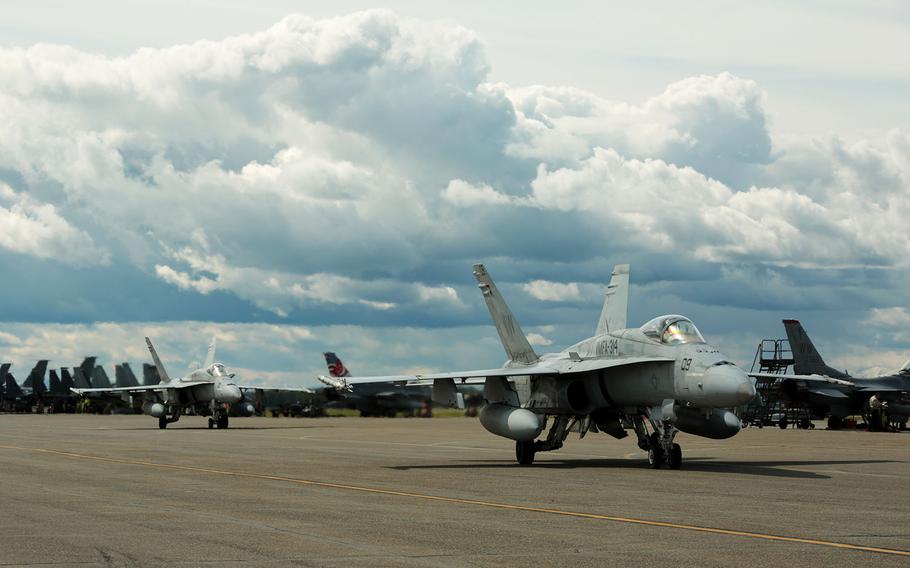
U.S. Marine Corps F/A-18C Hornet aircraft with Marine Fighter Attack Squadron (VMFA) 314, stationed at Marine Corps Air Station Miramar, California, taxi down the runway at Eielson Air Force Base, Alaska, during their participation in Red Flag-Alaska 16-2, June 7, 2016. (Donato Maffin/U.S. Marine Corps)
WASHINGTON — The Marines have made slight improvements to increase the number of training flight hours its non-deployed pilots receive monthly, but it remains far below what is required and could have long-term consequences for the service, Lt. Gen. Jon M. Davis told lawmakers Wednesday.
According to the Marines’ own standards, those pilots should have 16.5 hours of flight training each month. But they have received far less because the needed aircraft or the funds to pay for training have been transferred to deploying units.
Last year, non-deploying Marine pilots on average were getting only six to nine hours of flight training each month, Davis told the House Armed Services Committee’s subcommittee on readiness. Since Congress added funds to help address the readiness problem, hours of training have increased to average seven to 11 hours each month, said Davis, the Marines’ deputy commandant for aviation.
“It is an improvement but still six hours per month shy of what a trained-and-ready force requires,” he said.
Retired Cmdr. Chris Harmer, who flew SH-60F Sea Hawks and is now a senior analyst at the think tank Institute for the Study of War, said the single-digit monthly training hours are putting servicemembers’ lives at risk.
“A pilot flying only 100 hours a year is not really deployable and not really even safe,” Harmer said. “If you are flying just 7 to 11 hours per month you are not only completely non-proficient in combat, you are dangerously lacking in basic airmanship – takeoffs, navigation and landings. The pilots not in the deployment queue, their skills are eroding. They are a danger to themselves and their fellow Marines.”
Davis said the Marines continue to increase its flight training availabilities. But the longer-term consequences of having a new generation of aviators receive so few flight hours could lead to more “Class A” mishaps, where aircraft and crews are lost, because future leaders, who should have at least 2,000 hours of training, might only have 500 to 600 hours when they are called to guide a less-experienced aviator.
Davis called the lack of hours “concerning … the loss of experience this generation of Marines aviators has.”
The readiness of the Navy and Marine Corps’ helicopters and aircraft came into sharp focus after a string of fatal aircraft crashes in recent months, including the January 2016 collision of two CH-53E Super Stallions that killed 12 Marines off the coast of Hawaii. The investigation into that crash is close to complete, Davis said Wednesday.
copp.tara@Stripes.com Twitter:@TaraCopp